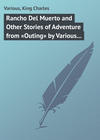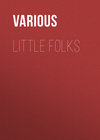Читать книгу: «Birds and Nature Vol. 11 No. 5 [May 1902]», страница 5
APPLE BLOSSOMS AND THE WARBLERS
It was a cold, rainy day toward the last of May. The apple trees were a mass of pink and white, but the fast gathering petals on the green carpet told the story; not for long would be wafted in through each window a whiff of such perfume as only Dame Nature, May and Company can distill. Unfortunately, I was in no mood to appreciate the beauties of a spring rain, for it was a very evident fact that the bad weather would prevent our anticipated bird walk. This fact I was bewailing, looking forlornly from the window out into the dripping world, when lo, I found that, contrary to expectations, the mountain does on occasion appear unto Mahomet!
On the lawn north of our house are nearly a dozen apple trees, two of which have branches overhanging the roof. I noticed that the foliage was in livelier motion than is usually caused by an easy shower, and on closer examination discovered that the trees were fairly alive with flitting forms, birds – warblers in all their glory. This was long before noon, and it was but the beginning of a state bordering on ecstasy for me which ended only when darkness fell, as it gave me the opportunity for making the acquaintance of a family, straggling members of which, only, I had met since my interest in feathered friends awakened.
To my delight I immediately brought within range of my glass the little fellow which I had seen the year before in the same tree, and had described in my note-book as “wearing a sun burst of black on a yellow vest.” On this occasion he was much in evidence, and the details of his handsome coat could be plainly detected. He is mostly black, and you may distinguish him by the broad white patch on his wings and the yellow breast which is decorated by a black pendant necklace. He is the magnolia warbler.
The chestnut-sided was well represented in the flock, and was an old friend. With us here in New Hampshire, he stays through the summer, but it is only at this season that we are apt to meet him. One recognizes him by his clear greenish-yellow crown and by the clearly defined chestnut streak on either side of his white vest.
Of course the Lord of the Manor is the Blackburnian warbler. To my great delight, he brought his wonderful flaming breast within four feet of me as I sat in one of the upper windows, watching him explore the branches. Mark him well. His upper parts are black, while his crown, throat and breast are flaming orange. He, too, wears a white vest, marked at the sides with black. So beautiful is he that words fail to describe him, while to see him flitting about among the apple blossoms was indeed “a picture no artist could paint.”
The next on my list was a discovery, and one over which I was jubilant. He was an elusive little fellow, and led me out into the rain and kept me standing there with the drops trickling down my face as I searched the branches for him. He was the daintiest sprite imaginable, whose blue-gray coat was like satin and whose white breast shading from a yellow throat could not make him conspicuous. It was only when I discovered that his back was a beautiful shade of bronzy-greenish-yellow that I knew he was the parula warbler, the blue yellow back. Then I went to the authorities to learn more about my stranger. Then I read that he wears another distinguishing mark, a brown streak across the throat. Back to the garden I went. Eureka! he satisfied all conditions, and was named! During this shower of warblers the parula was the most numerous species, excepting, perhaps, the chestnut sided.
A redstart came in for its share of admiration, and his beauty deserved it, but his evident appreciation of his own charms as he dashed here and there, opening and closing his fan-like tail, rather detracted from his character as he was viewed alongside his beautiful companions, who, to say the least, are modestly unaware of their charms.
Later, another discovery was made, and one that puzzled us for some time. At the first glimpse of him we said, “Chickadee, of course,” for we saw his black cap and his general black and white aspect. Then as he flew to a tree near the window, and we marked every point possible, we found that his back was closely striped with black and white, that his breast and belly were white, and that his wings were tinged with olive and had two white bars. We could not name him, and to my amazement Miss Wilcox did not have such a one in her “Common Land Birds of New England.” so not until I went to “Birdcraft” did I learn that my visitor was the black poll warbler. He was always intent upon his own affairs, seemed rather superior to the common herd, and was the last one of the visitation to leave me.
The Maryland yellow throat was here, too, away from his native alders, but seemingly not one bit confused to find himself an orchard bird. Perhaps he was only “going a piece” with his relatives and connections as they journeyed north. He is a beauty, and you may hear him in any alder swamp calling “witchy-titchy, witchy-titchy.”
I searched and searched for the black and white creeper whom we often see, but evidently he did not like a mixed crowd, for I did not discover him until several days later, when the main flock had passed on. The rest, however, were on every side, and so tame and confiding were they that a raised sash, or an ecstatic shout to a watcher at another window did not appear to disturb them in the least.
They were voiceless, though, intent upon nothing but dinner, except the redstart, who seemed to take settlement life as somewhat of a joke and, as he careered about, occasionally called to “sweet, sweeter, sweet.”
So the day passed, a continual surprise party, and the next day came, and still the flock lingered. But when the rain ceased, and the sun reappeared, they lifted their wings and hastened to pastures new, leaving only a straggler here and there. Will a spring rain this year find them passing over my apple trees? So may it be.
Grace E. Harlow.
RURAL RAMBLES
Over the hills as the pewee flies,
’Neath the glorious blue of summer skies;
Through briery wastes where wild birds dwell,
Deep in the shade of some rocky dell;
Where the pennyroyal and mint smell sweet,
And the blackberry ripens in cool and heat;
Down the winding path by the rippling rill,
By the old-time creek, by the dear old mill;
By the vine-clad fence, in the alder’s shade
Where woodchucks and merry squirrels invade;
Through spreading fields of daisies bright,
Where butterflies roam from morn till night;
Past upland and hollow whence scents are blown
Of clover blossoms and flowers well known;
Over swamp and marshland where red-wings sing,
While in flag and tussock their nest they swing;
Through ancient orchards, o’er meadows green,
Where roses and buttercups girt the stream;
Away through the woodlands’ emerald shade
By sparkling springs, through fern-clad glade,
By old quarry ponds where memories cling
And gay swallows circle on tireless wing;
From dawn’s early light till twilight’s gloaming,
With scenes ever changing, there’s pleasure in roaming.
– Berton Mercer.
THE HORSE
(Equus caballus.)
There are many objects which are so commonly seen that we deceive ourselves by thinking we know much about them, and yet should we make a special study of these same objects, often we would find ourselves woefully ignorant in regard to some of their most distinguishing characteristics.
Every day of our lives we see Horses. These frequently move with exquisite grace and beauty, stepping daintily and proudly as if hardly deigning to remain on earth, but seeming just ready to rise and fly as did the fabled winged horse Pegasus. With rapidly moving feet and we look on only to admire and wonder. And yet how comparatively few of those who watch the fascinating motion of a rapidly moving Horse know that the beautiful animal is running on only one toe, for that indeed is all it possesses for each foot. The foot proper extends as high as the apparent knee. This is in reality the wrist or ankle, and the apparent foot is but a finger or toe corresponding to the middle finger and middle toe of the hand and foot of man. The hoof may be likened to the finger nail. In fact, it is a great, thick, enlarged nail, finishing and protecting the toe above.
“The landscape speeds far away behind
Like an ocean driven before the wind,”
The Horse belongs to a great division, known as the odd-toed animals. There are about twenty-five species of these animals now existing and they are divided into four families, the one-toed Horses, the tapirs with four toes in front and three behind; the rhinoceroses with three toes, and the cony family with four toes on their fore feet and three on the hinderfeet. These four families are very different in their ways of living and are so unlike that one would not expect to find them relatives.
The native country of the Horse seems to be nearly the entire northern hemisphere, for fossil remains are found throughout this region, but in America the Horse (never found south of Alaska) became extinct, and for a time there were no Horses on the western continent. After the discovery of America, Horses were imported into the country and in time some escaped from their owners and formed herds which have multiplied until there are a great many wild Horses now roaming over the new world.
In Europe wild Horses also became extinct, but at a comparatively recent date; but in Asia and Africa there seems to be no time when the wild Horses have not been roaming over the plains and tablelands, as free as the wind.
On the steppes of southeastern Europe there are great herds of peculiar Horses, called tarpans. These are indeed freedom-loving animals and one can but feel a certain sympathy with their unwillingness to be tamed. They are a rather small Horse with thin, strong legs, a rather long, thin neck and a comparatively thick, blunt-muzzled head. They have small, brilliant, wicked eyes; the hair is thick and short in summer and inclined to curl; in winter it is longer and coarser and on the chin becomes almost like a beard.
Not content to roam in freedom by themselves, they will, if possible, entice domesticated Horses to join their number. On this account they are persistently hunted, as they do considerable damage.
The great herds are divided into families, each family led by a stallion who is sole ruler, taking the best of care of his subjects, but permitting no irregularity. These herds wander from place to place, usually running against the wind, and their keen sense of hearing warns them of approaching danger. The stallions do not fear beasts of prey and will sally forth against wolves and beat them down with their fore-hoofs.
The earliest representations of Horses and the fossil remains of the prehistoric animals show them to be of rather small size and not unlike the tarpans, suggesting the idea to some minds that the tarpans were the ancestors of the modern domesticated breeds, but the facility with which the Horse will resume its wild state makes opinions of little value.
The South American wild Horses, called “the wild Horse of the Pampas,” were all descended from a few domesticated Horses left in the town of Buenos Ayres, which was abandoned some time after the year 1535. These Horses are called cimarrones. They roam in immense herds and are considered a nuisance, as they consume good pasturage and also lead away the domestic Horses. The mustangs of Paraguay, although domestic Horses, vary little from the conditions of the wild Horses of the pampas, as they are much neglected, live out of doors all the year around and really degenerate for want of care.
A. von Humboldt gives an interesting description of the life of the Horse in the Llanos, the great grassy plains lying further to the north. When the never-clouded sun turns the grass to dust, the Horses and cattle roam about, pressed by hunger and thirst, and by inflating their nostrils endeavor to discover by the damper air currents localities where the water has not yet evaporated.
The Mules, using more intelligence, beat with their fore-feet the prickly exterior of the melon cactus and quench their thirst with the watery pulp.
When finally the rainy season begins, the Horses still meet with danger and trouble, as the swelling rivers surround their grazing places and the colts are frequently drowned. Jaguars often lurk in the tall grass and crocodiles are a constant menace. Even among the fish there are dangerous enemies. The electric eels “can kill the largest animals by means of their powerful discharges if their efforts are concentrated upon certain portions of the body.”
The Horses are often their own enemies. Becoming frantic with terror, in a frenzy of fright, they destroy themselves by dashing against rocks or rushing over precipices.
There is much that is interesting in regard to the half-wild Horses of North America. These are all descendants of imported varieties, and while owned by the various ranchmen, they have the freedom of the range or prairie. Ofter they are seen by their owners only at the annual “round-up,” when they are driven into the “corrals” in order that the colts may be marked with the brand of the owner.
One can spend much time studying the instructive facts in regard to the interesting wild and half-wild Horses of the globe, and still feel that much remains unlearned. Yet all will admit that the most beautiful and perfect types of Horses are those bred under the direct supervision of man.
Of those which attain the greatest speed, most prominent are the English thoroughbred, the American race horse, and the Trakehnen Horse, the finest Horse of German breed.
These are all the result of many years of careful selection, each finding among its ancestors the noted Arab steeds, “praised as the noblest animal of creation by the naturalist, the expert and the poet.” The Horses of the Levant and the Barbary have also aided to render the English thoroughbred the greatest race horse of the old world. The American trotters have not been behind, for as far back as 1889 the maximum recorded pace was one mile in two minutes and three and three-fourths seconds.
For the practical uses of life there seem to be as many breeds of Horses as are necessary to meet the varying requirements of an industrial civilization. We find all kinds and sizes, from the heavy and powerful Percheron or Clydesdale cart Horse, standing sometimes over six feet in height, to the smallest Shetland pony which may be even less than three feet at the withers, and we find Horses of various colors, of various lengths of mane and tail, and of varying degrees of intelligence.
While all Horses are not well treated, yet no animal is so respected and loved by man and no other animal has become so close a companion. While many nations as a whole have loved and cherished their Horses, the Arab steeds have been most appreciated and have entered closest into the daily life and thought of their masters. Only when it has attained its seventh year do they consider the education of the Horse complete and meanwhile it has been the constant companion and friend of its master.
In the extravagant and poetical language of the East, one Arab thus speaks of his beloved Horse: “Do not tell me that this animal is my horse, say that he is my son. It runs more quickly than the wind of a storm, more swiftly than the glance that sweeps the plains. It is pure as gold. Its eye is clear and so keen that it sees a hair in the dark. It overtakes the gazelle in its course. To the eagle it says: I hurry on like you. When it hears the shouts of girls it neighs with joy, and the whistling of bullets rejoices its heart. From the hands of women it begs for alms; the enemy it beats in the face with its hoofs. When it can run to its heart’s desire, it weeps tears. It recks not whether the sky be clear or the blasts of the desert obscure the light of the sun with dust; for it is a noble steed and despises the rage of the storm. There is no other in this world that could vie with it. Swift as a swallow, it courses on; so light is its weight that it could dance on the breast of your beloved and not annoy her. It understands all like a son of Adam, and all it lacks is speech.”

![Birds and Nature Vol. 11 No. 5 [May 1902]](https://cdn.litres.ru/pub/c/cover_100/25570807.jpg)



















